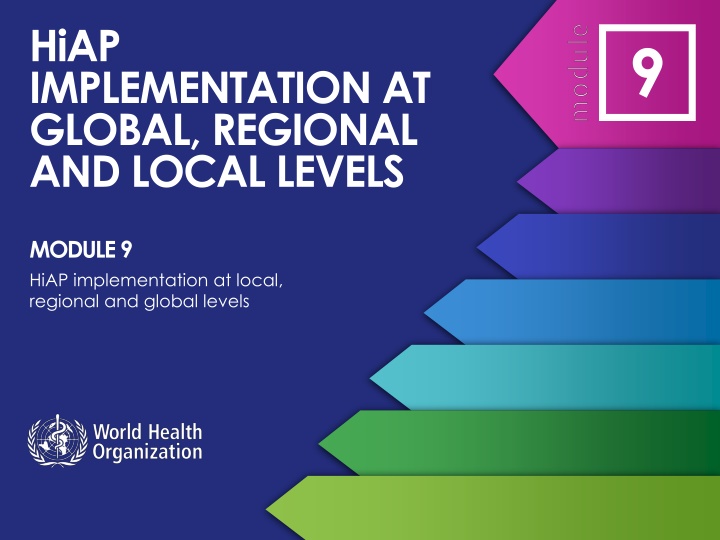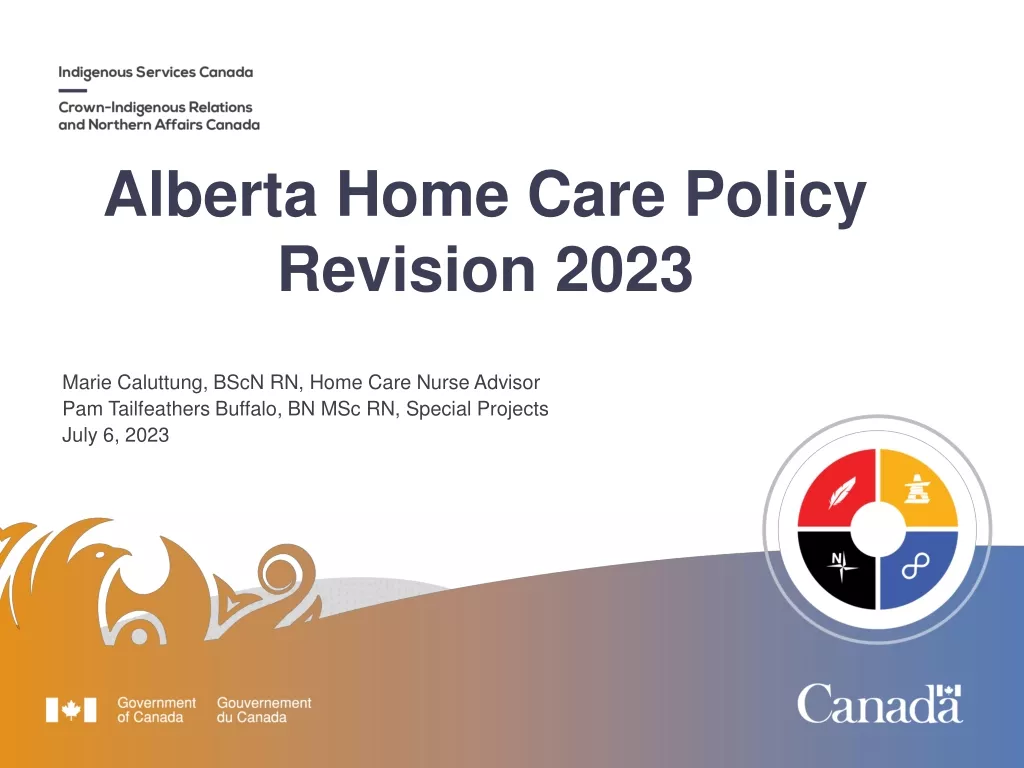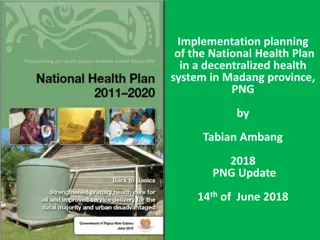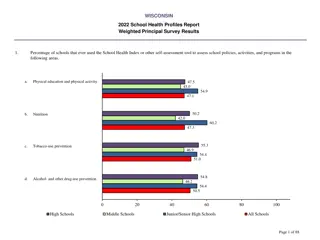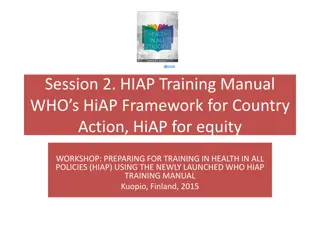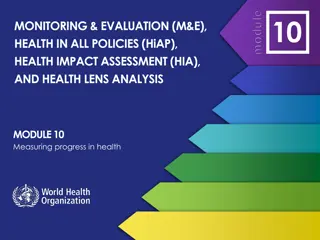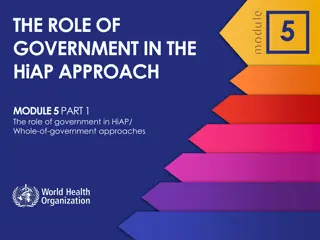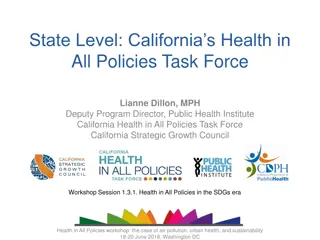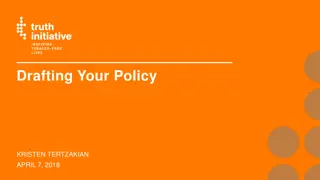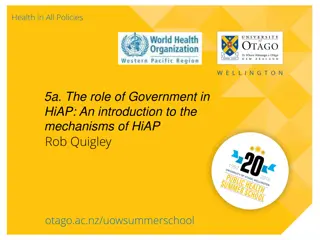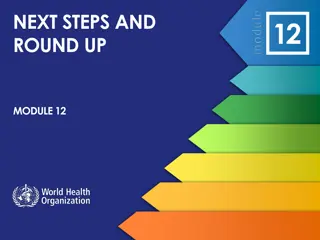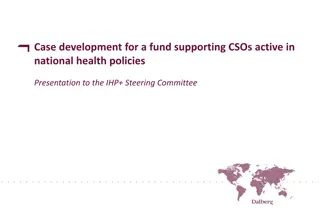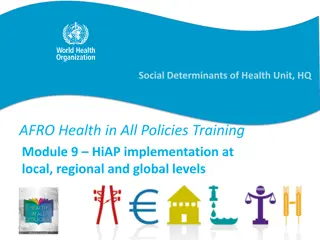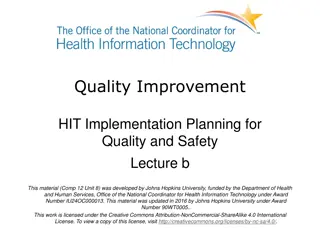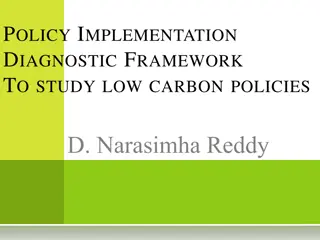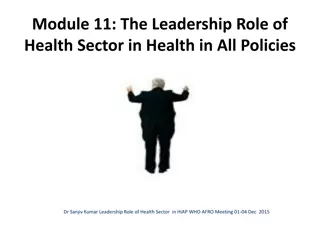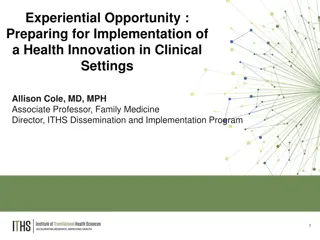Health in All Policies: Implementation Insights at Different Levels
Real-life experiences, learning objectives, and frameworks related to Health in All Policies (HiAP) implementation globally, regionally, and locally. Understand the key drivers, domains of equity, and mechanisms for sustainability in HiAP initiatives. Discover how to initiate, sustain, and implement HiAP effectively while leveraging strategic opportunities like those seen in Namibia and Zambia.
Download Presentation

Please find below an Image/Link to download the presentation.
The content on the website is provided AS IS for your information and personal use only. It may not be sold, licensed, or shared on other websites without obtaining consent from the author.If you encounter any issues during the download, it is possible that the publisher has removed the file from their server.
You are allowed to download the files provided on this website for personal or commercial use, subject to the condition that they are used lawfully. All files are the property of their respective owners.
The content on the website is provided AS IS for your information and personal use only. It may not be sold, licensed, or shared on other websites without obtaining consent from the author.
E N D
Presentation Transcript
HiAP IMPLEMENTATION AT GLOBAL, REGIONAL AND LOCAL LEVELS 9 MODULE 9 HiAP implementation at local, regional and global levels
LEARNING OBJECTIVES 9 Discuss examples of HiAP implementation at the local, regional and/or global level
WHAT SUPPORTS HEALTH IN ALL POLICIES IMPLEMENTATION? 9 HiAP facilitates intersectoral relationships and policy development to address health and equity issues while also contributing to other sectors policy goals. HiAP has now been implemented in various forms in over 20 countries, working at different levels of government. While there is no single or simple model for HiAP, there is a growing evidence base of conditions that support HiAP, and distinguish the approach from other forms of collaborative action. There is increasing interest in how the effectiveness of the approach can be optimized, including the enablers and barriers to HiAP implementation.
LEARNING FROM HiAP EXPERIENCES AN ANALYTIC FRAMEWORK 9 Key drivers of implementation Key domains of equity lens Opportunities for initiation Orientation for equity lens in policies and interventions Social, economic and political context Overview of health and society Organization and structure of the government Mechanisms of sustainability Key drivers of sustainability Areas for learning in Health in All Policies based on experiences of HiAP practice Source: WHO (2013) Health in All Policies Analytic Framework for Learning from Experiences
REAL-LIFE EXPERIENCES OF HiAP PRACTICE 9 Initiate HiAP Sustain HiAP Implement HiAP
HOW TO INITIATE HEALTH IN ALL POLICIES 9 Presence of political will political support or interest Initiate HiAP Find the right entry point for your situation context specific Align HiAP with core business and strategic priorities build on what already exists Be opportunistic Seek co-benefits and define shared goals Find HiAP champions or policy entrepreneurs Sustain HiAP Implement HiAP Begin to establish trust and credibility
HOW TO INITIATE HEALTH IN ALL POLICIES: REAL-LIFE EXPERIENCES 9 LEVERAGING STRATEGIC AND REFORM OPPORTUNITIES Namibia and Zambia are using the Sustainable Development Agenda as an entry point to more closely link health with other sectors work. Country Development Plans have enabled existing strategic priorities to be aligned with HiAP and helped to shape a whole- of-government agenda e.g. Sudan and Suriname Bhutan is exploring how HiAP can be applied using the existing governance and processes of their Gross National Happiness (GNH) strategy, where policies are shaped and vetted through specific GNH mechanisms.
HOW TO INITIATE HEALTH IN ALL POLICIES: REAL-LIFE EXPERIENCES 9 HEALTH ISSUES/INCREASING BURDEN OF DISEASE Climate and obesity action were important drivers to introducing HiAP to California key priorities for the then Governor Arnold Schwarzenegger. Californian HiAP Task Force established as the governance body through the introduction of an Executive Order. INFLUENCERS South Australia s Thinker in Residence programme provided for an international expert to explore how health and well-being could be improved in the state. HiAP was recommended as an approach to collaborative policy-making, using the government s strategic plan as an overarching governance framework.
HOW TO IMPLEMENT HEALTH IN ALL POLICIES: GOVERNANCE AND LEADERSHIP 9 Initiate HiAP Commitment and leadership at the highest level Strong mandate Formal structures Considerations of the political context A different role for the health sector / Ministries of Health Sustain HiAP Implement HiAP
HOW TO IMPLEMENT HEALTH IN ALL POLICIES: PROCESSES, STRATEGIES AND TOOLS 9 Different ways of working context specific Initiate HiAP Successful partnerships and building relationships Human and financial resources e.g. core HiAP team Use of research and evidence Dedicated methods Health Lens Analysis, Health Impact Assessment, 90-Day Projects, policy briefs Meetings and events information sharing and creating visibility Sustain HiAP Implement HiAP Informal networks
HOW TO IMPLEMENT HEALTH IN ALL POLICIES: REAL-LIFE EXPERIENCES 9 GOVERNANCE, MANDATE AND LEADERSHIP California Executive Order by the Governor mandated the establishment of a HiAP Taskforce Partnership with Central Government in South Australia provides a clear statement of the Government s commitment to a HiAP approach The Leadership Group that oversees the Canterbury HiAP Partnership (New Zealand) is a city-/regional-level example of good governance Qu bec, Canada HiAP supported by the Council of Ministers HiAP is integral to the Finnish Government program with promoting well-being and health as one of five overall objectives
HOW TO IMPLEMENT HEALTH IN ALL POLICIES: REAL-LIFE EXPERIENCES 9 PROCESSES, STRATEGIES AND TOOLS Scotland Health Impact Assessments (HIA) and the production of evidence reviews are widely promoted and applied to different policy areas California has a dedicated HiAP team to coordinate HiAP work, and support cross sector partnerships Relationship building and partnerships across sectors are actively supported, including with community members by the Metropolitan District of Quito, Ecuador, to progress the Healthy Neighbourhoods closing the gap in health inequality policy initiative
HOW TO SUSTAIN HEALTH IN ALL POLICIES 9 Initiate HiAP Respond and adapt to changing political, administrative and cultural environments - sustaining HiAP requires agility Institutionalizing HiAP e.g. use of public health legislation/legal tools Monitor progress and evaluate Continue to invest in and find HiAP champions and policy entrepreneurs Acknowledge achievements, reflect and share lessons Sustain HiAP Implement HiAP Capacity building to work in new ways
HOW TO SUSTAIN HEALTH IN ALL POLICIES: REAL-LIFE EXPERIENCES 9 RESPOND AND ADAPT TO CHANGING CONTEXTS Finland with a long-standing history of HiAP implementation is adapting its approach to better align with the global Sustainable Development Agenda and the Government s national approach to combining health, well-being and equity objectives. INSTITUTIONALIZING HiAP USE OF LEGAL TOOLS The law can be a powerful tool for guiding long-term policy goals and sustaining HiAP: The Well-being of Future Generations (Wales) Act 2015 Qu bec Public Health Act 2001 Thailand National Health Act 2007 South Australian Public Health Act 2011.
HOW TO SUSTAIN HEALTH IN ALL POLICIES: REAL-LIFE EXPERIENCES 9 MONITOR PROGRESS AND EVALUATE To support the Healthy Shandong initiative(China), which includes a HiAP approach, the Shandong province incorporates strong monitoring and evaluation mechanisms, including an annual white paper on the health status of the region s population every year to track progress and engage partners across the district in health and well-being. Namibiaplans a determinants of health of the nation report every two years.
THE ROLE OF BROADER SOCIETY AND CITIZENS FOR ACTION ON THE DETERMINANTS OF HEALTH 9 Thailand s National Health Assembly demonstrates participatory governance in action
THREATS TO HEALTH IN ALL POLICIES ACTION 9 The dominance of siloed decision-making and narrow definitions of core business Resource constraints Weak governance structures and arrangements Lack of support from senior officials HiAP REQUIRES AGILITY
FIRST GLOBAL STATUS REPORT ON HEALTH IN ALL POLICIES 9 Designed and published by The Global Network for Health in All Policies (GNHiAP) in 2019 Provides baseline information on HiAP practice and describes different HiAP models from around the world
9 SURVEY AND DATA 48 question, on-line survey between October 2018 and January 2019 Distributed to known HiAP implementers and circulated via snowball sampling technique 41 valid survey responses 22 countries captured including different levels of government national, subnational, local Design comprised questions on key conditions that support successful HiAP practice
FIRST GLOBAL STATUS REPORT ON HEALTH IN ALL POLICIES 9 METHODOLOGICAL CONSIDERATIONS Survey captured a range of HiAP models, although known to be some missing models due to sampling method Responses by individual respondents may not fully represent the breadth of HiAP activity in their respective jurisdiction Some countries provided responses for different levels of government each response was accounted for separately WHO definition of HiAP used as a key screening criterion (systems level approach rather than general or issue-specific intersectoral/multisectoral action for health)
FIRST GLOBAL STATUS REPORT ON HEALTH IN ALL POLICIES 9 DATA ANALYSIS Data analysed by two key factors: Thematic Analysis Governance and leadership 1) Phase of maturity Emerging Progressing Established Resources for HiAP (personnel and monetary) Entry points Ways of working Capabilities (individual and organizational) 2) Level of government National Subnational Local HiAP priorities and outcomes Monitoring, reporting and evaluation
LOCATION OF RESPONDENTS SHOWING MATURITY OF PRACTICE AND LEVEL OF GOVERNMENT 9
FIRST GLOBAL STATUS REPORT ON HEALTH IN ALL POLICIES 9 KEY FINDINGS: GOVERNANCE AND LEADERSHIP The more established models of HiAP were more likely to have: Most respondents had some level of governance arrangements or formal structures in place to support their HiAP approach a strong authorising environment with political support governance mechanisms or formal structures to oversee HiAP Political support for HiAP in respondent jurisdiction by maturity of practice (percentage) Formal governance arrangements to oversee HiAP in a jurisdiction by maturity of practice (percentage) 100 92 90 78 Yes N=18 N=10 N=13 N=18 N=10 N=13 50 No 40 Don t know 39 17 33 28 10 10 8 5 Emerging Progressing Established Emerging Progressing Established
FIRST GLOBAL STATUS REPORT ON HEALTH IN ALL POLICIES 9 KEY FINDINGS: GOVERNANCE AND LEADERSHIP Jurisdictions with more established HiAP practice are more likely to have governance mechanisms or formal structures in place to support the implementation of HiAP Governance structures to facilitate intersectoral action is a key feature of HiAP, which distinguishes the practice from other forms of collaborative action Level of governance mechanisms or formal structures in place to support the implementation of HiAP by maturity (percentage) N=18 N=10 N=13 70 No governance mechanisms in place 56 54 Discussion and planning about governance mechanisms is underway 38 33 Some governance mechanisms in place 20 11 10 8 Strong governance mechanisms in place Emerging Progressing Established
FIRST GLOBAL STATUS REPORT ON HEALTH IN ALL POLICIES 9 KEY FINDINGS: RESOURCES (PERSONNEL) The greatest dedication of personnel resources occurs in HiAP models that are more established, and investment in personnel is also most common at the subnational level of government Percentage of respondents with a dedicated HiAP team by maturity of practice N=18 N=10 N=13 Yes 8 17 No 39 40 92 Don t know Don t know 60 44 Emerging Progressing Established
FIRST GLOBAL STATUS REPORT ON HEALTH IN ALL POLICIES 9 KEY FINDINGS: RESOURCES (PERSONNEL) Dedicated personnel are key given the significance of partnerships and relationships in HiAP Percentage of respondents with a dedicated HiAP team that support HiAP action by level of government 68 N=6 N=19 N=16 50 50 50 44 Yes No 21 Don t know 11 6 Local Subnational National
FIRST GLOBAL STATUS REPORT ON HEALTH IN ALL POLICIES 9 KEY FINDINGS: RESOURCES (MONETARY) As with a dedicated team, a dedicated budget is most common in the established phase and at the subnational level of government Percentage of respondents with a dedicated budget for HiAP activities by maturity of practice N=18 N=10 N=13 Yes 10 17 22 No 40 46 54 61 50 Don t know Emerging Progressing Established
FIRST GLOBAL STATUS REPORT ON HEALTH IN ALL POLICIES 9 KEY FINDINGS: RESOURCES (MONETARY) Having a dedicated HiAP budget is not a measure of the quality or commitment of HiAP practice HiAP implementation is possible with minimum budgets 100 Percentage of respondents with a dedicated budget for HiAP activities by level of government N=6 N=19 N=16 63 47 Yes 37 No 25 Don t know 16 12 Local Subnational National
FIRST GLOBAL STATUS REPORT ON HEALTH IN ALL POLICIES 9 OTHER CONDITIONS FOR SUCCESS Entry points and ways of working are context-specific, reflecting local social and political cultures as well as government structures. This speaks to the context-specific nature of policy-making. Many actions can be taken; these are dependent on timing (e.g. windows of opportunity) and contextual factors Health diplomacy and negotiation skills are critical capabilities to support HiAP, as is the ability to respond and adapt in the face of changing political, administrative and cultural landscapes Monitoring, reporting and evaluating processes are complex, but important, and more likely to occur once practice has matured Establishing priorities provides strategic direction. Determining short- and long-term outcomes will become increasingly important as the evaluation of HiAP global practice evolves
FIRST GLOBAL STATUS REPORT ON HEALTH IN ALL POLICIES 9 Governance Advancing the HiAP model Establish the need and priorities for HiAP Conditions for success Ensure monitoring, evaluation and reporting Governance and Leadership Identify supportive structures and processes Resources for HiAP Putting HiAP into practice Entry Points Ways of Working Frame planned actions Build capacity Capabilities (Individual and Organisational) Facilitate assessment and engagement Monitoring, Reporting and Evaluation HiAP Priorities and Outcomes Governance
End of Module 9 Please continue to Module 10
